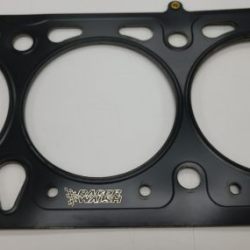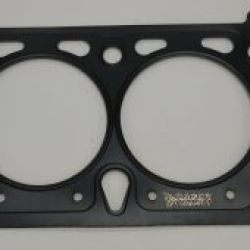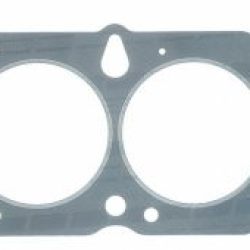RWA 1578-43 is .043″ thick and designed for the “Pinto” 2.0 OHC engine. Not all solid copper gaskets are created equal. Our 1578-43 is manufactured by SCE and uses premium 99% pure copper sheets rolled to our specifications (choice of 12 different thicknesses) and tested for uniform flatness to assure precise cylinder head-to-block alignment and eliminate uneven loading. After processing, each gasket is annealed to ensure optimum mating and provide measurable gains in cylinder sealing, as evidenced by lower leak-down percentages. O-ringing recommended.
1. Before installing the gasket, perform a visual check to insure that no damage occurred during
shipping, the gasket(s) should be flat and free of scratches.
2. SCE Copper head gaskets are annealed in a vacuum oven after punching to provide soft
malleable gaskets which are ready to use, do not use a torch to soften the gaskets.
3. Pro Copper series head gaskets (P prefix) require the use of a sealant for coolant and oil
passages and o-ring combustion seals installed in the head or block. (P/N 31542 o-ring kit).
4. If you are installing o-rings make sure that the o-ring diameter and location accommodates
both bore opening and combustion chamber shape. This will determine the minimum inside
diameter of the o-ring.
5. If the combustion chamber or bore is so large that o-rings must be placed less than .100” apart
between cylinders, it is advisable to use a “figure 8” pattern for o-rings (see figure #2). This allows
for more even clamp load over the entire head surface.
6. Recommended o-ring protrusion is not more than 25% of gasket thickness. Example: Gasket
thickness .043”, o-ring height is .008” to .010”. Gasket thickness .050”, o-ring height is .010” to .012”.
NOTE: For extreme boost or heavy nitrous an O-ring-Receiver-Groove arrangement is recommended
(see figure #3). When using a receiver-groove the wire may be higher than 25% of gasket
thickness; wire height & width determines receiver groove depth & width by maintaining the relationships
in the figure 3 illustration.
7. Good engine building practice requires clean flat surfaces and clean head bolt threads. If
threads are tapped through the deck, use care in sealing threads to prevent coolant migration up
the bolt.
8. As with any performance application it is strongly recommended that head bolts be re-torqued.
Run the engine to operating temperature, shut down and allow it to cool completely. With the
engine cold, follow the recommended torque sequence, one bolt at a time back the fastener off
just enough to relieve the friction set, then re-torque to specification.






